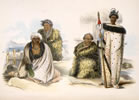In Māori culture, humans are seen as deeply connected to the land and to the natural world. Kaitiakitanga grows out of this connection and expresses it in a modern context.
Tangata whenua
Tangata whenua – literally, people of the land – are a group who have authority in a particular place, because of their ancestors’ relationship to it. Humans and the land are seen as one, and people are not superior to nature. The natural world is able to ‘speak’ to humans and give them knowledge and understanding. Human life is about aligning oneself with the natural world.
Mystical relationship
In some tribal traditions, humans changed into birds, fish and other creatures. There are also many examples where people identified the human body with features of the landscape. All of these traditions show an intimate experience of nature. Anthropologists have described it as a mystical involvement with the natural world.
Landscape and body: taunaha whenua
Taunaha whenua is a custom where a chief claims land by naming it after a part of his body. When Tamatekapua, captain of the Te Arawa canoe from Polynesia, saw Maketū peninsula he said, ‘Te kūrae rā mō āku whakatipuranga. Ko te kūreitanga o taku ihu!’ (The land that we see ahead I shall claim for my descendants. I shall name it the bridge of my nose!) 1
The chief Tia, who had also arrived on the canoe, looked toward Rangiuru and said, ‘Te toropuke i runga rā, ahu mai ki ngā maunga nei, ko te takapū o Tapuika!’ (That small hill away to the south, and the land between it and the mountain yonder, shall be called the belly of Tapuika!) 2
Sacred land
The Ngāti Tūwharetoa chief Mananui Te Heuheu asserted authority over the tribe’s lands, and made them sacred, by equating them with his body. His grandson, Tūreiti Te Heuheu, explains:
[H]e manipulated his body so it spread over a vast distance. One of his thighs was upon Tītī-o-kura, another on Ōtāiri. One of his shoulders was upon Paretetaitonga, another on Tūhua. His head was on Tongariro and his body lay upon Taupō. This was done to render the land sacred and as a domain for his spiritual authority… 3
